Editors Note
At the critical stage when the crypto market shifts from concept to industry, stablecoins will be a key link connecting the on-chain and off-chain financial worlds.
The Artemis team’s report, “The Future of Stablecoins,” provides us with profound insights by systematically combing through the development history, current application status, and future prospects of stablecoins.
This report focuses on the transformation of the stablecoin ecosystem: from the early issuance (issuance)-centered to todays distribution (distribution) and actual usage (usage).
The use of stablecoins is more important than their supply: The report emphasizes that it is more important to understand the actual application scenarios of stablecoins than to simply focus on their total supply. Stablecoins have expanded from a single trading tool to diversified uses such as payment, savings, cross-border remittances, and DeFi collateral.
Power shifts from issuers to distributors: As the threshold for issuing stablecoins is lowered, distributors (such as wallets, exchanges, and fintech platforms) have gradually become the dominant force in value capture. They not only integrate stablecoins, but also gain market influence through user relationships and experience shaping.
The rise of new infrastructure: To adapt to diverse use cases, new infrastructure is developing to support programmability, compliance, and value sharing. Stablecoins are no longer simple digital assets, but dynamic financial primitives that can adapt to the needs of different scenarios.
Data Insights: The report provides detailed data analysis, showing that stablecoin supply and trading volume are mainly concentrated in centralized exchanges (CEX), DeFi protocols, and maximum extracted value (MEV) infrastructure. Unattributed wallets also account for a considerable share, representing the growth potential of grassroots users and emerging use cases.
Special statement: All articles of DePINone Labs are for information and knowledge purposes only and do not constitute any investment advice.
This report is compiled by DePINone Labs. Please contact us for reprinting.
——The following is the original text of the research report——
Executive Summary
The question is no longer whether stablecoins will reshape global finance, but how.
In the early days, stablecoin growth was measured by total supply. The key challenge is trust: which issuers are credible, compliant, and capable of scaling? This question has been answered. Today’s leading issuers have demonstrated operational resilience, and new entrants are entering the market with institutional backing and regulatory readiness.
As issuance becomes commoditized, power is shifting from minting to distribution.
The days of staggering profits at the issuer level are numbered – distributors are starting to realize their influence and capture their fair share of value.
Given this shift, it’s increasingly important to understand which applications, protocols, and platforms are seeing real growth . Are stablecoins driving real payments? Cross-border money flows? Institutional finance?
In the competitive stablecoin space, distributors need to capture the value they create to survive. Every digital bank, wallet, or fintech that moves a stablecoin is generating revenue — the only question is who’s keeping it.
Builders who recognize this are moving away from the default choice toward options that offer programmability, embedded financial rails, and modular infrastructure.
Just as early innovation was defined by reserve quality and protocol security, the next era will be defined by product design and distribution strategy.
Those who do the right thing will define the future of finance.
About this report
This report aims to redefine our understanding of the growth of stablecoins: from issuance to implementation.
This is the first in a series of reports examining the evolving landscape of stablecoin use cases, mapping the distribution of key applications and estimating reserve-based revenues associated with major categories.
By analyzing usage patterns over time, we reveal the evolution of use cases—and where value is truly being created. While the data in this report highlights many of the largest players, not all entities are captured due to attribution limitations.
Our goal is to support smarter conversations, developments, and investments across both emerging and established use cases.
Industry Insights
We are in the midst of a massive shift — a shift in perspective, where stablecoins are no longer viewed as “cryptocurrency” but rather “global infrastructure”; a shift in utility, where financial builders are actively reinventing their products to take advantage of these new rails. The playing field is changing; get ready. - Ran Goldi, SVP of Payments and Networking at Fireblocks
Stablecoin growth has reached escape velocity, and regulatory clarity is opening the door for institutions. The next frontier is not just about who has scale today — it’s about the business models of all players in the stablecoin supply chain, from issuers to distributors to holders. We will definitely see changes and challengers in the value chain and value accumulation over the next 12-24 months. - Martin Carrica, VP of Stablecoins at Anchorage Digital
Stablecoins are the first primitive of the new financial stack. Everything we know about finance is being rebuilt on stablecoins. And the winners? They will control distribution. - Simon Taylor, Head of Strategy and Content at Sardine
Stablecoins have gone from experimental to essential in just a few years, and their product-market fit is unquestionable. But we are now entering a period where issuance and liquidity alone are not enough to generate sustained growth. The next phase of stablecoin adoption will involve new factors, including sharing economic benefits with partners, ease of on-chain and off-chain integration, and the extent to which programmability features are leveraged. - Jelena Djuric, Co-founder and CEO of Noble
Stablecoins have proven extremely profitable, whether through Tether’s outsized returns, Stripe’s Bridge acquisition, or $10 trillion in annual settlement volume, and are now solidifying their position as the foundation of global financial infrastructure. - Stefan Cohen, Partner at Bain Capital Crypto
Table of contents
Stablecoin Landscape
From coinage to market
Use Case Analysis
Total Market
Centralized Exchanges (CEXs)
Decentralized Finance (DeFi)
Maximum Extractable Value (MEV)
Unattributed Wallets
in conclusion
Stablecoin Overview
Beyond Market Value
Stablecoins have become one of the most widely used products in cryptocurrency. With a supply of over $240 billion and annual on-chain transaction volume exceeding $7 trillion, they rival traditional payment networks in scale. But these numbers tell an incomplete story.
Supply reflects the amount of stablecoins in existence, not how much they are used, where they are flowing, or what they are used for. Meanwhile, volume reflects a mix of on-chain human activity and bots, but fails to capture off-chain data.
Usage is the new trend
Not all stablecoins are created equal in terms of liquidity. Some lie dormant. Others are key drivers of real economic activity across platforms, users, and regions.
As can be seen in The State of Stablecoins in 2025, there are clear differences between the ecosystems. Stablecoins on Ethereum tend to be used as DeFi collateral and trading liquidity, while stablecoins on Tron are more commonly used for remittances and payments in emerging markets. USDC has a higher share of institutional flows, while USDT thrives on its reach and accessibility.
These usage patterns not only reflect the direction in which value is flowing; they also provide builders with opportunities to target underserved or high-growth niches.
Understanding where stablecoins are being implemented and what functions they fulfill is now the clearest signal to judge the authenticity of adoption and where the next wave of innovation will emerge.
From institutional issuance to market distribution
Historical value of the issuer
In the early days of stablecoins, value capture was concentrated on the issuer. Maintaining a 1:1 peg is a difficult problem at scale that few have solved well.
Tether and Circle dominate not only because they were early entrants, but also because they are among the few issuers that can consistently manage issuance and redemption, reserve management, banking partner integration, and survival of market stress.
By monetizing reserve yields (primarily short-term U.S. Treasuries and cash equivalents), even modest interest rates translate into significant revenue. Double down on early success: exchanges, wallets, and DeFi protocols are built around USDT and USDC, reinforcing the network effects of distribution and liquidity.
Distribution as a value layer
Trusted custody, liquidity, and redemption are no longer differentiators — they are expectations. As more issuers enter the market with similar capabilities, the issuers themselves matter less. What matters is what users can do with stablecoins.
As a result, power is shifting from issuers to distributors. Wallets, exchanges, and applications that integrate stablecoins into real-world use cases now have influence and leverage. They own user relationships, shape experiences, and increasingly determine which stablecoins gain traction.
And they’re monetizing that status. Circle’s recent IPO filing shows that it paid nearly $900 million in 2023 to partners like Coinbase — more than half of its total revenue — for integrating and promoting USDC.
What is happening now is that issuers pay distributors, not the other way around.
Many distributors are moving further up the chain. PayPal launched PYUSD. Telegram partnered with Ethena. Meta is exploring stablecoin rails again. Fintech platforms like Stripe, Robinhood, and Revolut are embedding stablecoins directly into payment, savings, and trading functions.
Issuers are not standing still. Tether is building wallets and payment rails. Circle is growing across the board with payment APIs, developer tools, and infrastructure acquisitions. But the dynamic is clear: distribution is now the strategic high ground.
Built for programmability and precision
As stablecoin adoption expands, new infrastructure is emerging—built for programmability, compliance, and value sharing. Issuance alone is no longer enough to meet competition. Stablecoins must adapt to the needs of the platforms that drive usage.
The next generation of stablecoins includes programmable features such as hooks, compliance rules, and conditional transfers. These features make stablecoins application-aware assets that automatically route value to merchants, developers, liquidity providers, or related parties without the need for off-chain protocols.
Each use case has a unique context. Remittances prioritize speed and conversion, DeFi requires composability and collateral flexibility, and FinTech integration requires compliance and auditability. The emerging infrastructure stack aims to serve these diverse needs, enabling the stablecoin layer to dynamically adapt to its context rather than providing a one-size-fits-all solution.
Crucially, this infrastructure shift enables more precise value capture. Programmable flows mean value can be shared across the entire stack — not just hoarded by the issuer. Stablecoins are becoming dynamic financial primitives, shaped by the incentives and architecture of the ecosystems they move in.
Focus on use cases
As the value capture of stablecoins moves downstream, it is the distributors who define their actual usage. Wallets, exchanges, fintech applications, payment platforms, and DeFi protocols determine which stablecoins users can see, how they interact with them, and where they create utility. These platforms shape the user experience and control the demand side of the stablecoin economy.
Analyzing the actual use of stablecoins in areas such as payments, savings, trading, DeFi, and remittances can reveal who is creating value, where the friction points are, and which distribution channels are effective. By tracking the flow of stablecoins between wallets and platforms, we can gain insight into the infrastructure and incentives that influence their adoption.
Use Case Analysis
This report focuses on stablecoin use cases related to on-chain activity from attributed wallets — addresses identified as belonging to specific entities such as centralized exchanges, DeFi protocols, or institutional players.
Among these known (also called “tokenized” or “labeled”) actors, stablecoin usage is currently concentrated in three main contexts:
Centralized Exchanges
DeFi Protocols
MEV Infrastructure
The following table shows the supply and volume share of each category in April 2025:

Together, these three categories account for 38% of total stablecoin supply and 63% of total stablecoin trading volume.
Untagged addresses make up the majority of the remaining supply and transaction volume. These are wallets that are not directly linked to a known institution, exchange, or smart contract. We will explore trends in untagged addresses later in this report.
To estimate the revenue from the supply business, we took the current float and calculated an annual yield of 4.33% based on the current effective federal funds rate in the U.S. In reality, many issuers will have higher yields, but this is just a rough guide to estimate the approximate amount of expected returns.
Total Market Overview
Total stablecoin supply: $240 billion
Total stablecoin trading volume: $3.1 trillion (last 30 days)
Reserve income: $10 billion (assuming fixed-floating annual returns)
Total stablecoin supply by use case
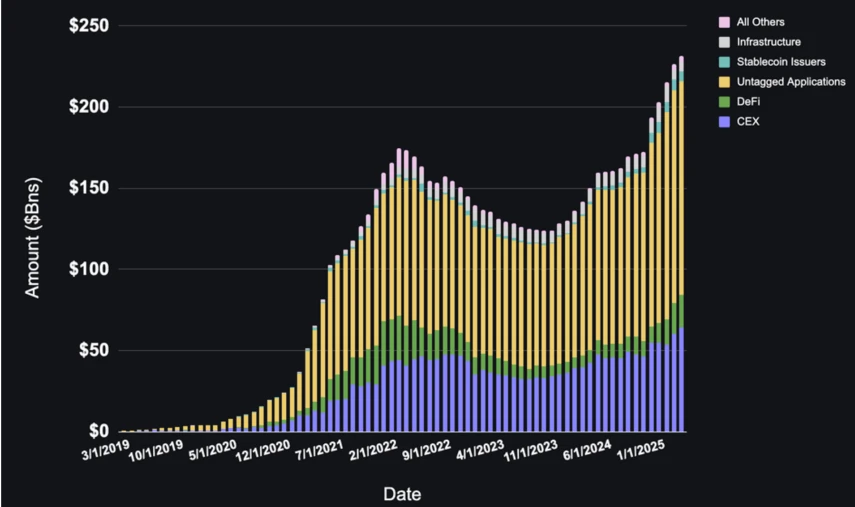
The distribution of stablecoin supply reveals which platforms and use cases are attractive enough to retain float.
Total supply has been climbing steadily since the summer of 2023, reaching an all-time high this year, with CEX, DeFi, and untokenized wallets all seeing high growth.
Top 10 entities by stablecoin supply
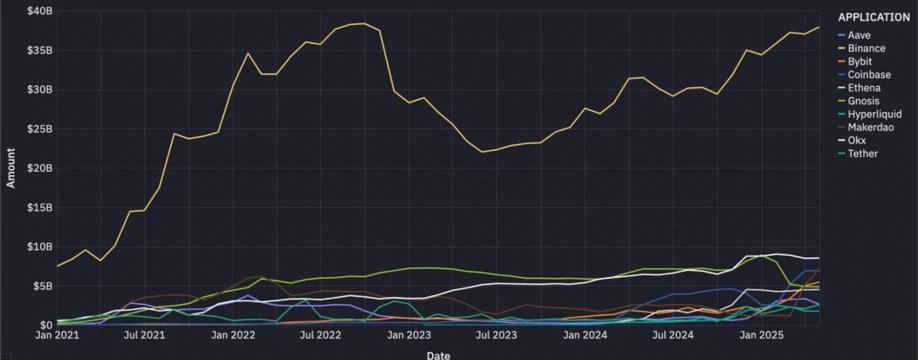
Most stablecoin supply is concentrated on centralized exchanges, with Binance taking a sizable lead. DeFi protocols and issuers also account for a significant share.
Total stablecoin volume by use case
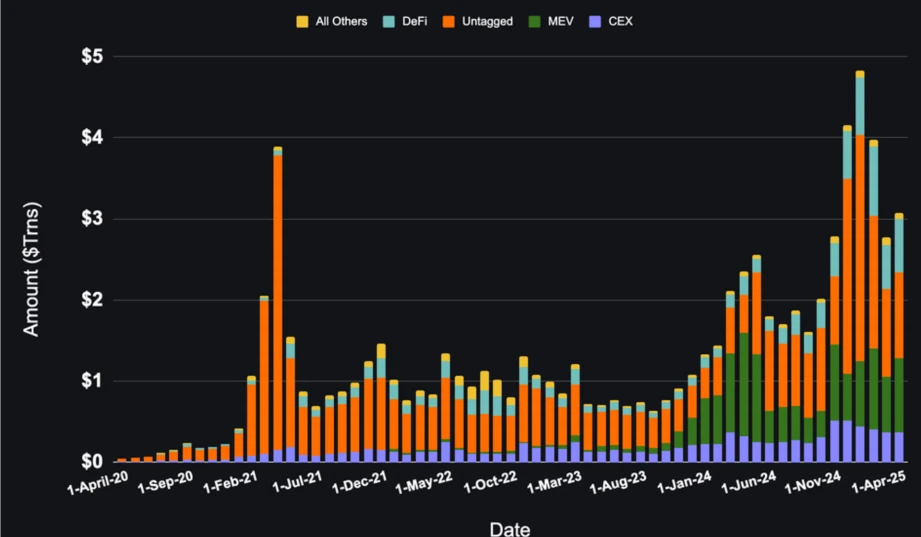
Total stablecoin volume has been climbing steadily since the summer of 2023, with particularly large increases during periods of high market activity. DeFi has seen the highest volume growth, while MEV and untagged wallets have high but volatile volumes.
Top 10 entities by stablecoin trading volume
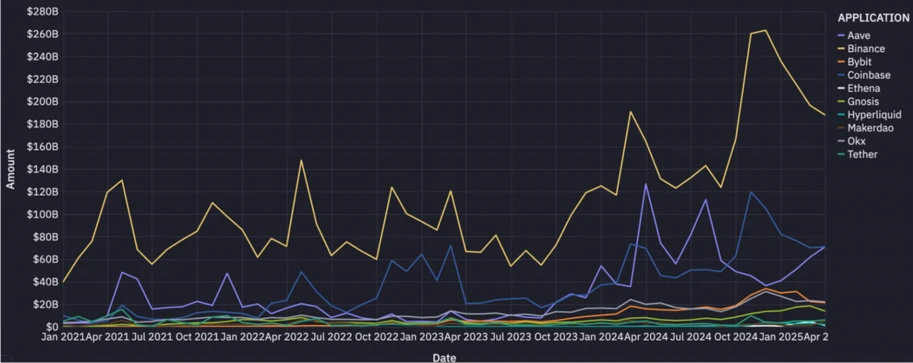
Entities with the highest stablecoin trading volumes tend to be centralized exchanges, followed by DeFi and issuers.
CEX trading volume does not reflect transactions on CEX platforms, as most transactions occur off-chain. Instead, it reflects user deposits and withdrawals, inter-exchange transfers, and internal operational activities.
Drill down by use case
Centralized exchanges continue to anchor stablecoin supply and account for a large portion of the circulation in various ecosystems.
In terms of transaction volume, DeFi protocols and MEV-driven players are currently the most active, highlighting the growing role of on-chain applications and composable infrastructure. This section will delve deeper into these categories to analyze key players, emerging trends, and revenue opportunities.
Centralized Exchanges
Stablecoin supply share: 27%
Stablecoin volume share: 11% (last 30 days)
Reserve income: $3 billion (assuming fixed-floating annual returns)
Top 5 CEXs by Stablecoin Holdings
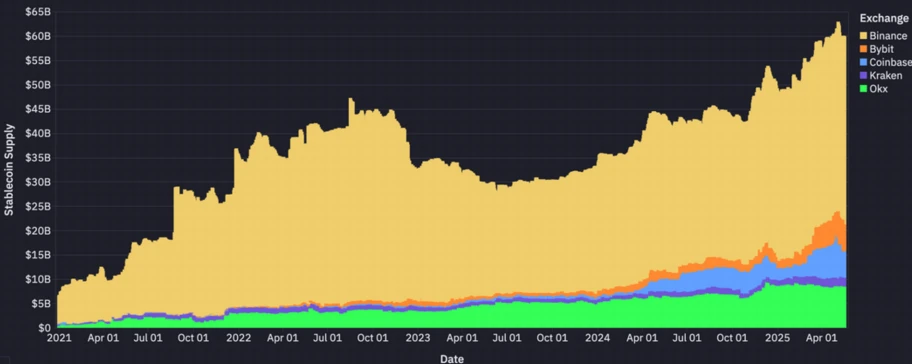
Supply on top centralized exchanges (CEXs) has nearly doubled since local lows in 2023. Supply on Coinbase, Binance, and Bybit tends to fluctuate with the market, while supply on Kraken and OkX has grown more steadily.
Top 5 CEXs by Stablecoin Transfer Volume
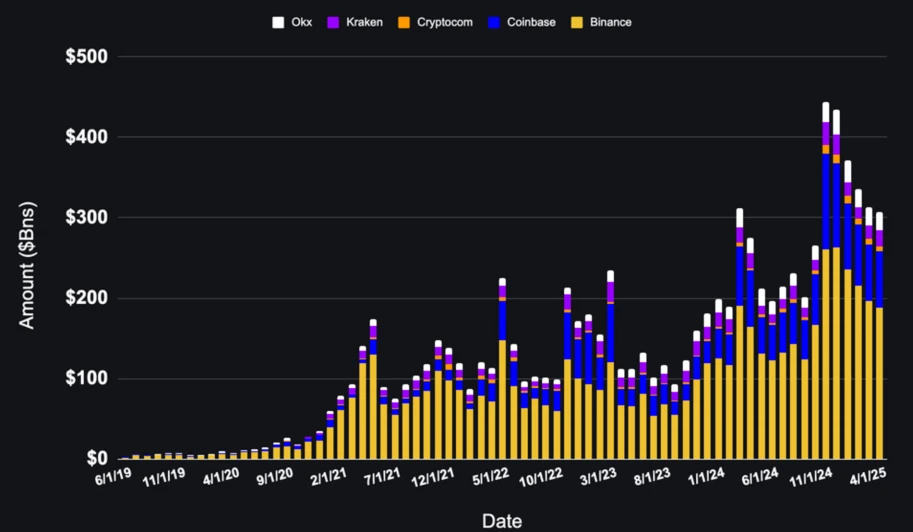
It is difficult to obtain specific data on how stablecoins are used by centralized exchanges (CEXs) because most of the activity occurs off-chain. Funds are often pooled together and their specific uses are rarely disclosed. This opacity makes it difficult to assess the comprehensiveness of stablecoin usage within centralized exchanges (CEXs).
Stablecoin trading volume attributed to centralized exchanges (CEXs) reflects on-chain activity related to deposits, withdrawals, inter-exchange transfers, and liquidity operations, rather than internal trading, margin collateralization, or fee settlement. Therefore, it is best viewed as an indicator of user interaction with exchanges rather than a measure of total trading activity.
DeFi
Stablecoin supply share: 11%
Stablecoin volume share: 21% (last 30 days)
Reserve income: $1.1 billion (assuming fixed-floating annual returns)
DeFi stablecoin holdings by major categories
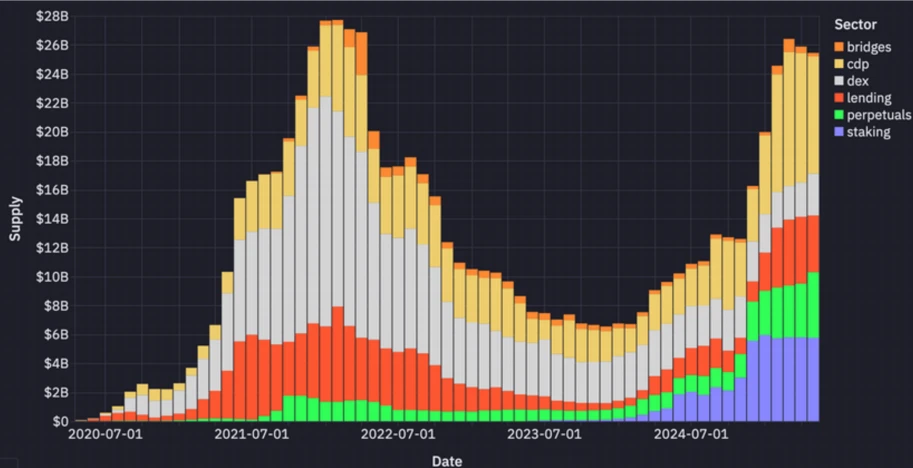
The supply of DeFi stablecoins comes from collateral, liquidity provider (LP) assets, and the settlement layer of lending markets, decentralized exchanges (DEX), and derivatives protocols. The supply of CDPs, lending, perpetual contracts, and staking has almost doubled in the past 6 months.
DEX’s share of supply has dropped significantly, not because DEX usage has dropped, but because DEX’s are more capital efficient.
With Hyperliquid’s explosive popularity, the supply locked in perpetual contracts has increased significantly recently.
DeFi stablecoin transaction volume by major categories
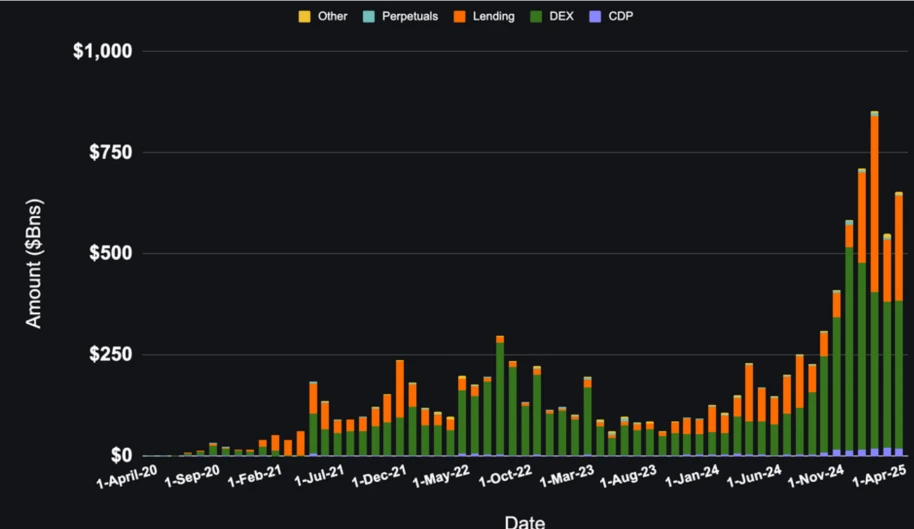
Over the past 6 months, DeFi monthly stablecoin trading volume has grown from ~$100B to over $600B, led by huge growth in DEXs, lending, and CDPs.
In the DeFi space, stablecoins are deployed in the following key areas:
DEX Pools
Lending Market
Collateralized debt position
Others (including perpetual bonds, bridge bonds and pledges)
These segments use stablecoins in different ways — whether as liquidity, collateral, or payments — shaping user behavior and protocol-level economics.
Top DEXs by Stablecoin TVL
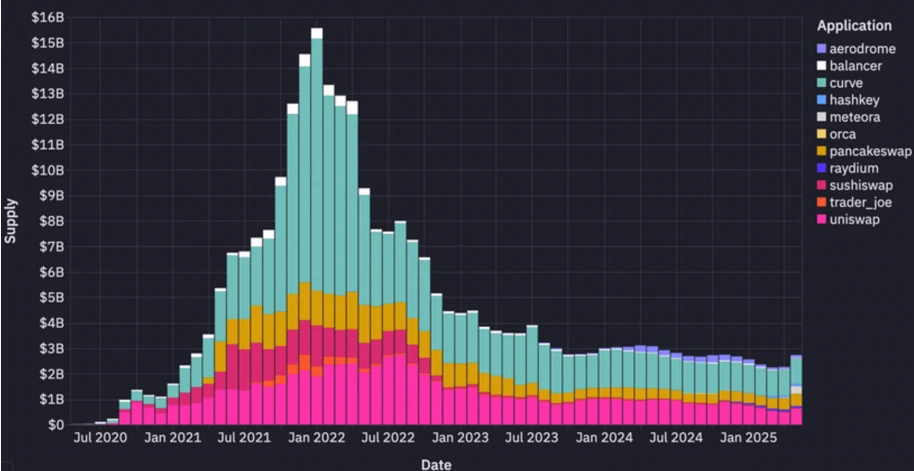
Pooled liquidity, stablecoin-focused DEXs, and cross-protocol composability reduce the need for DEXs to maintain high stablecoin floats.
DEX’s share of total stablecoins
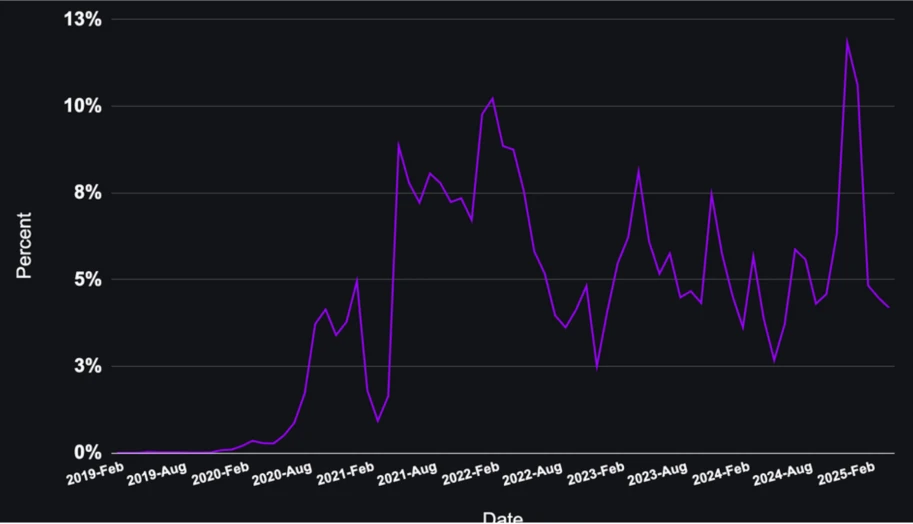
The trading volume of stablecoins in DeFi mainly comes from DEX. The proportion of DEX in the total trading volume will fluctuate with market sentiment and trading trends. Recently, the trading volume of memecoin has soared to more than 500 billion US dollars, accounting for 12% of the total trading volume.
Top lending markets by stablecoin TVL
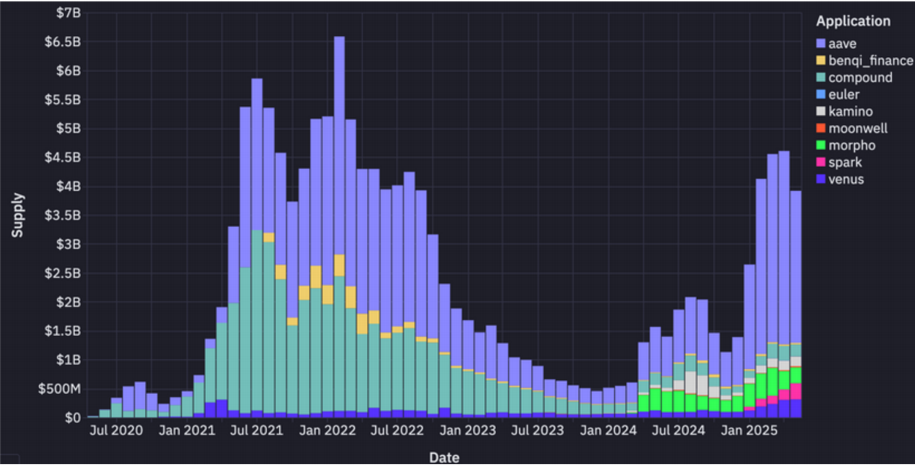
Although lending has fallen from its peak, Aave has shown strong recovery momentum, while newer protocols such as Morpho, Spark, and Euler have also gained traction.
Top Collateralized Debt Positions (CDPs) by Stablecoin TVL
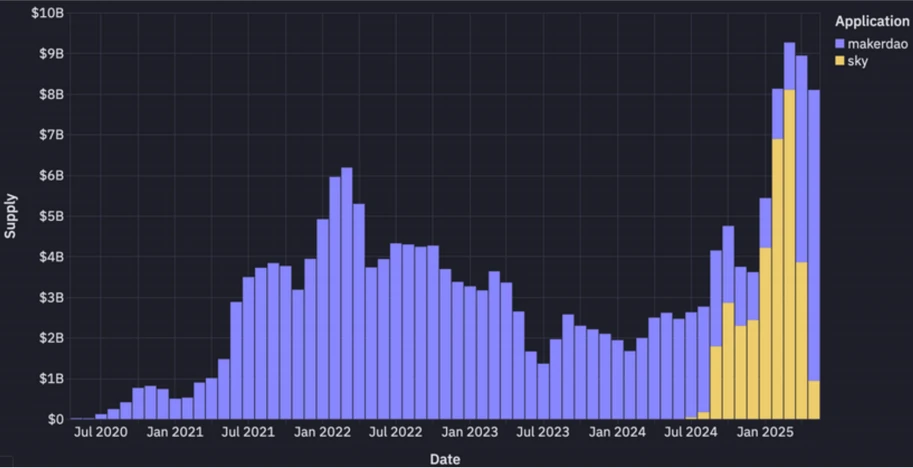
MakerDAO continues to manage one of the largest stablecoin treasuries in the DeFi space, with a high savings rate driving rising adoption of DAI. They hold billions of dollars in stablecoins that play a key role in maintaining DAI’s peg to the dollar.
Other top DeFi protocols by stablecoin TVL
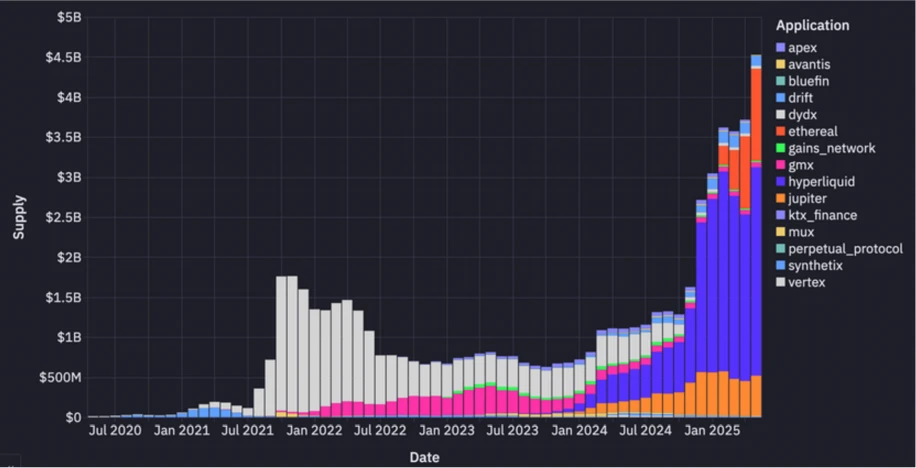
Stablecoins also play a key role in supporting derivatives, synthetic assets, perpetual contracts, and trading protocols in DeFi.
Supply rotates over time between various perpetual swap protocols, currently concentrated in Hyperliquid, Jupiter, and Ethereal.
MEV
Stablecoin supply share: < 1%
Stablecoin volume share: 31% (last 30 days)
Reserve income: Not applicable (assuming fixed-floating annual return)
MEV vs. non-MEV transaction volume
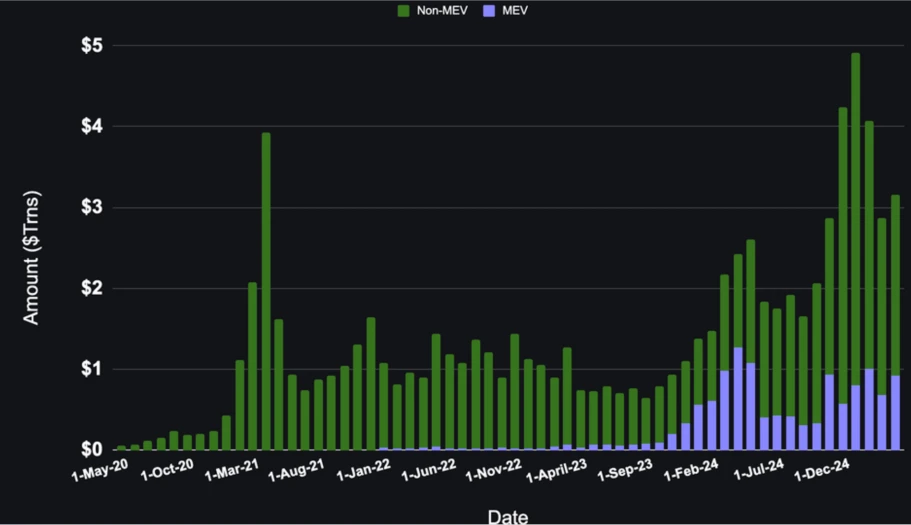
MEV bots extract value by reordering transactions. Their high-frequency behavior causes a disproportionate share of on-chain transactions, and they often reuse the same funds.
The above chart separates MEV-driven activity to distinguish between bot volume and manual volume. MEV volume surges during peak trading periods and fluctuates as blockchains and applications try to counter MEV strategies.
Predicting revenue for a high volume, low float use case like MEV is not as straightforward as predicting high float use cases. Predicting reserve yields is less applicable here, but these use cases can employ a variety of monetization strategies such as transaction fees, spread capture, embedded financial services, and application-specific monetization.
Unattributed Wallets
Stablecoin supply share: 54%
Stablecoin volume share: 35% (last 30 days)
Reserve income: $5.6 billion (assuming fixed-floating annual returns)
Stablecoin activity in unlabeled wallets is more difficult to interpret, as the intent behind transactions must be inferred or confirmed through private data. Even so, these wallets account for the vast majority of stablecoin supply and often the majority of transaction volume.
The components of the unlabeled wallet include:
Retail Investors
Unidentified institution
Startups and SMEs
Dormant or passive holders
Unclassified smart contracts
While attribution models are imperfect, this “grey space” category of wallets accounts for a growing share of real-world payment, savings, and operational processes, many of which do not neatly map onto traditional DeFi or trading frameworks.
Some of the most promising use cases are emerging here, including:
P2P Remittance
Startup Treasury
Individual dollar savings in an inflationary economy
Cross-border B2B payments
E-commerce and merchant settlement
In-game economy
As regulatory clarity improves and payments-centric infrastructure continues to attract capital, these emerging use cases are expected to expand rapidly—particularly in regions underserved by traditional banks.
We’ll explore this in detail in part 2 of this series. For now, let’s look at some general trends:
Number of holders by holdings
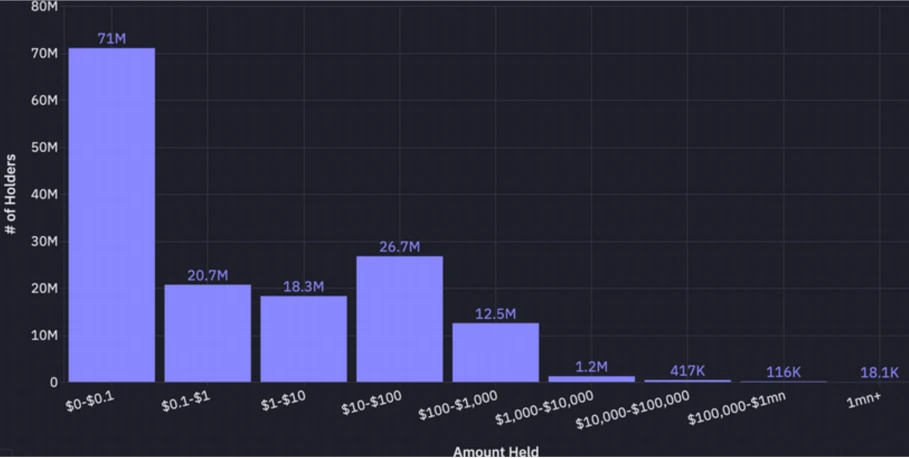
Despite the large number of unattributed wallets — more than 150 million — the vast majority hold negligible balances. More than 60% of unattributed wallets hold less than $1 in stablecoins, and fewer than 20,000 wallets hold more than $1 million in stablecoins.
Total stablecoin holdings by wallet size

When we turn our focus to the wallet size corresponding to each balance range, the situation completely flips.
Less than 20,000 unattributed wallets with balances over $1 million collectively hold over $76 billion, or 32% of the total stablecoin supply.
Meanwhile, wallets with balances below $10,000 — more than 99% of untagged wallets — collectively hold $9 billion, less than 4% of the total stablecoin supply.
Most wallets are small, but the majority of the untokenized stablecoin supply is held by a very small number of high-value groups. This distribution reflects the dual nature of stablecoin use: broad grassroots access at one end and significant institutional or large-cap concentration at the other.
in conclusion
The stablecoin ecosystem has entered a new phase where value will increasingly flow to developers building applications and infrastructure.
This marks a critical maturation of the market; the focus will shift from the money itself to the programmable systems that make it work.
As regulatory frameworks improve and user-friendly applications proliferate, stablecoins will see exponential growth. They combine the stability of fiat currencies with the programmability of blockchain, making them a fundamental building block for building the future of global finance.
The future of stablecoins belongs to the developers who create the applications, infrastructure, and experiences that unlock their full potential. As this shift accelerates, we can expect more innovation in the way value is created, distributed, and captured across the ecosystem.
The future will not be defined just by stablecoins, but by the ecosystem that forms around them.










